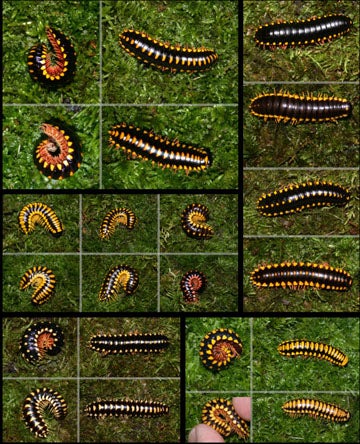ECU researchers discover complex pattern of mimicry evolution in local millipedes
GREENVILLE, N.C. — An intriguing and compelling example of evolution by natural selection has been demonstrated in a study involving Southern Appalachian Mountain millipedes, conducted by East Carolina University biologists Drs. Paul Marek and Jason Bond.

This compilation of photos shows a selection of millipede species collected from throughout their range in the Southern Appalachian Mountains. Despite the fact that they are different species, many look very similar as a consequence of mimicry.
This summer, Bond, director of the newly formed ECU North Carolina Center for Biodiversity, published an article with his former doctoral student, Marek, in the Proceedings of the National Academy of Sciences USA. Their study demonstrates that a large group of millipede species, located in the mountainous regions of Virginia, Kentucky and Tennessee, has evolved a set of defense mechanisms and color patterns that serve as a warning to potential predators.
Over many years of evolution, the millipedes now have bright red and yellow colors and complex patterns that potential predators consider a danger signal. These blind millipedes also produce a dangerous, very toxic, hydrogen cyanide gas.
Bond notes that a single millipede “can secrete 18-fold the amount of hydrogen cyanide necessary to kill a pigeon-sized bird.”
The study documents a form of mimicry known as “Müllerian mimicry” in seven species that vary considerably in their warning coloration and distribution. Named for the German naturalist Fritz Müller, this form of mimicry involves a biological system in which two or more species are harmful or dangerous and have evolved similar warning coloration or patterns in an effort to maximize the signal to predators.
“This is a remarkable example of natural selection and Müllerian mimicry,” Bond said. “Most examples of this are found in the tropics and are limited to taxa like butterflies and frogs.”
The article has generated considerable interest in scientific circles and recently was reviewed in an issue of Current Biology. Marek is now a National Institutes of Health PERT postdoctoral research associate at the University of Arizona.
– – – – – –
Contact: Jason Bond, director ECU North Carolina Center for Biodiversity
(252)328-6718 or bondja@ecu.edu